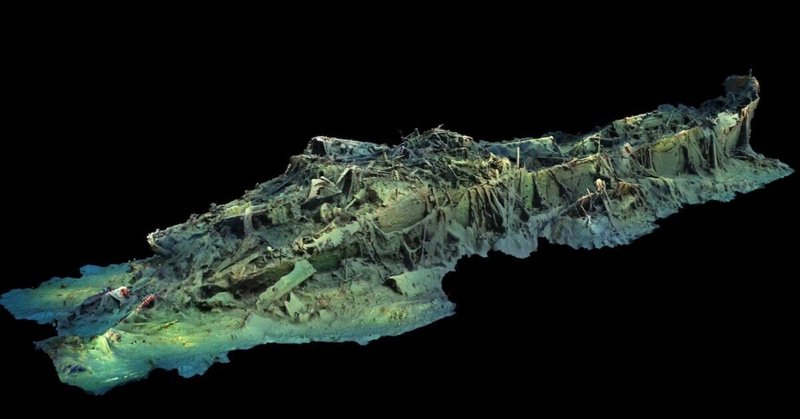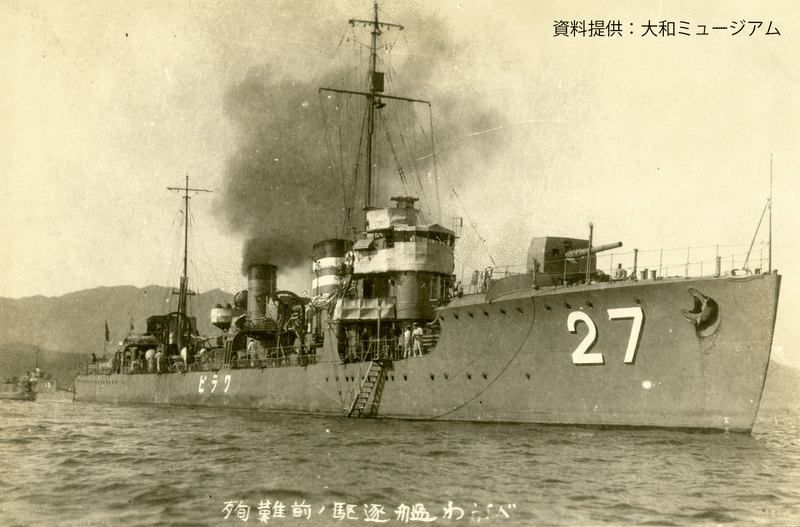
the Imperial Japanese Navy destroyer Warabi Search Project (1) - The Mihonoseki Incident, an unprecedented accident in naval history
Through several surveys conducted from 2020 to 2021, the World Scan Project (W.S.P.), led by underwater archaeologist Kotaro Yamafune, in collaboration with the Kyushu University Research Center for Coastal Seafloor (Professor Hironobu Suga) and others, discovered the Imperial Japanese Navy destroyer Warabi, which sank to the seafloor during the Mihonoseki Incident (1927), and The Warabi was found for the first time in 93 years.
Initially, there was a place off the coast of Mihonoseki in Matsue City, Shimane Prefecture, that was famous as a fish reef (a raised area formed on the seafloor by rocks and manufactured structures where fish gather to form a fishing ground), and there was a legend that a warship may have sunk there, as fishing nets were occasionally caught in the area.
This area was the site of the Mihonoseki Incident, a catastrophe that occurred on August 24, 1927, when four warships of the Imperial Japanese Navy, which were conducting nighttime exercises, collided with each other, resulting in the loss of four warships and 119 lives. However, the details of the sinking site are unknown, and only folklore has been handed down.
Then, in 2021, local university students and organizations launched a research project. The investigation to search for the sunken ship has begun.
Before we begin, let us unravel the "Mihonoseki Incident," the project's genesis.
Washington Naval Disarmament Treaty" restricts mainline vessels
The "Mihonoseki Incident" was caused by training to improve ship handling and operation techniques
World War I (1914-1918) dealt a severe blow to the participating countries' economies. The Washington Naval Disarmament Treaty of 1922 was concluded amidst growing calls for reconstruction and economic stability in the participating nations. The five signatories were the United States, the United Kingdom, Japan, France, and Italy. The main content of the treaty was to limit the number of mainline vessels (mainly cruisers and battleships) owned to avoid a recurrence of war by preventing a race to build battleships.
The ratio of total ship displacement for each country's holdings was set at five each for the U.S. and the U.K., 3 for Japan, and 1.75 each for France and Italy. Japan's holdings were 315,000 tons. Aircraft carriers were similarly restricted. The current state of fortifications and naval bases was maintained for the U.S., U.K., and Japan. In contrast, fortifications and new or strengthened naval bases in Pacific island areas (including those acquired in the future) were forbidden for Japan.

Japan, outnumbered in terms of the number of vessels it possessed, stepped up the construction of cruisers, of which there were no restrictions, and destroyers, which were smaller and more agile.
No restrictions on training. These words are from Heihachiro Togo, the hero of the Battle of Japan, who defeated the Russian fleet in the Russo-Japanese War when the Washington Disarmament Treaty imposed possession limits on Japanese warships.
At 22:00 on August 24, 1927, the Allied Fleet began military exercises off Mihonoseki, Shimane Prefecture. The squadron consisted of six battleships, including Nagato and Mutsu, two light cruisers, Tatsuta and Kinu, and 25 destroyers, including Jintsuki, Naka, Warabi, and Reed, and cruisers, including Jintsuki and Naka. Destroyers originally belonging to the Kou force were transferred to a different squadron at the last minute of the exercise, and some protested that it would be dangerous.
The most tragic accident in naval history.
An hour after departing Mihonoseki, the "JINDORI," attempting to approach the enemy fleet from behind, received irradiation fire from the enemy fleet and changed course while increasing speed to take evacuation action. As she changed course to the east, she successfully dodged a destroyer crossing her path, but her relief was short-lived when the unlighted Warabi appeared before her. The "Jintsu" collided with the Warabi from the right front, causing the Warabi to explode and cut it in half. The Warabi exploded and was cut in half. According to records, the sinking began suddenly and lasted 26 seconds.
The "Naka," which had been following behind the "Jintsu," then collided with the destroyer "Reed," who was trying to cross her path. Both vessels avoided sinking, but Naka lost her bow, and Reed lost the rear part of her hull. The ship had been conducting nighttime exercises without lights and other harsh training, resulting in a total of 119 lives lost, 27 from the Reed and 92 from the Warabi, which sank.



After 93 years, the latest technology approaches the deep sea.
It was in 2020 that light was shed on the Warabi, which had been lying at the bottom of the sea for a long time. It was 93 years after the ship sank.
In May 2020, underwater photography using a multibeam* was conducted at a location about 33 km northeast of the Mihonoseki Lighthouse (Matsue City, Shimane Prefecture). The "Mihonoseki Offshore Incident Memorial Association," a local group, conducted the filming. The group has been working to prevent the incident from fading by holding a memorial service every summer and disseminating information through events.
After analyzing the data taken by the photographers, they discovered a massive structure on the seafloor, approximately 50 meters long, 5.4 meters high, and 8 meters wide, which they estimated was most likely the destroyer Warabi, sunk in the 1927 Mihonoseki Incident, and consulted Kotaro Yamafune, a local underwater archaeologist. The group felt that it would be a waste to leave the Warabi unexplored, so they asked WSP to join them in conducting a more advanced survey in September 2020, together with experts from various fields, including Kyushu University's Frontier Research Center for Shallow Sea Floor Research.
*Multibeam sounding survey equipment is a type of survey equipment that can grasp a wide area of the seafloor topography by emitting sound waves in a fan shape from a transmitter/receiver equipped on the bottom of the vessel toward the seafloor and capturing the reflected sound waves.
Is the shadow projected by the multibeam the destroyer Warabi? (continued)
この記事が気に入ったらサポートをしてみませんか?
